The old Smyrna Population: 3.8 million
Old name: Smyrna
Favourite son: Homer
Pity poor İzmir, doomed, despite its wonderful waterside location, to play permanent second fiddle to its more glamorous northern neighbour, İstanbul.
Not that it was always like this, for İzmir is a city with a haunting history. In the 19th century what was then Smyrna was able to give the capital a run for its money. As a flourishing port, its population was so cosmopolitan that the town was often labeled “Infidel Smyrna (Gavur Smyrna)”. Its merchants lived in comfortable sea-facing mansions where they could enjoy the best that life had to offer. But all that came to an abrupt end in 1922 when a fire that broke out in disputed circumstances destroyed much of the town centre. It was the end of the Greek community that had lived in the city since time immemorial.
The end, too, of Smyrna’s reputation for cosmopolitanism. Modern İzmir is a pretty solidly Turkish city albeit one with a reputation for supporting the opposition CHP party when it comes to elections.
On Sept. 9, 1922, Mustafa Kemal Atatürk’s arrival in Smyrna marked the effective end of the Turkish War of Independence. You’ll see the date on all sorts of landmarks about town.
Don’t leave town without
- grabbing one of İzmir’s famous kumru sandwiches stuffed with white cheese and tomatoes from a vendor working the shoreline
- trying fresh mussels stuffed with rice and pine nuts and sprinkled with lemon
- sampling a boyoz, a flaky pastry that may have arrived with the Serphadic Jewish community when they were expelled from Spain in 1492 (be warned that many on sale in the city are not made from the traditional recipe which insisted on sesame oil)
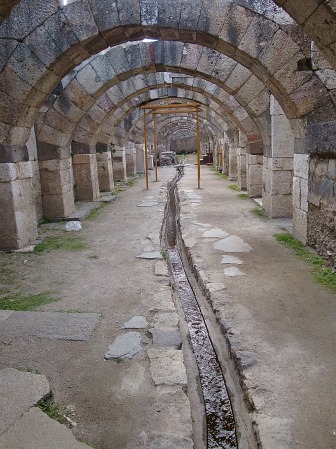 Backstory
Backstory
At first glance İzmir looks like an entirely modern city, although the original settlement here is thought to have dated back to around 3000 BC.
It was with the arrival of Greek colonists from Colophon that ancient Smyrna really began to flourish. However, its development was not all plain sailing and the city had to be refounded by Alexander the Great and then again by the Romans.
Afterwards it endured a typically Anatolian history of occupation and reoccupation by everyone from the Arabs and Selçuks to the Crusaders and Genoese, before finally falling under the Ottoman sway in 1415.
Around town
The most conspicuous reminder of İzmir’s distant past is the old Graeco-Roman agora which survives in ruinous condition in deepest Basmane, an area of cheap hotels and restaurants that extends southwest of the eponymous train station.
Homer, the famous Greek author of the Iliad and the Odyssey, is thought to have been born in Smyrna and would surely have strolled in the original agora. However, the remains that survive today date from a later remodelling ordered by Emperor Marcus Aurelius after an earthquake brought the buildings tumbling down in 178.
You’ll be able to make out a stoa (colonnaded walkway), and lots of drainage channels, but there’s little sign now of the temples that once graced the site. 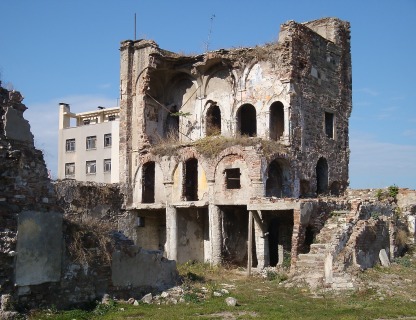 Ruined house of Sabbatai Zevi beside the Agora
Ruined house of Sabbatai Zevi beside the Agora
Many of the finds from ancient Smyrna are on display in the town’s Archaeology Museum (closed Mondays), which stands on the hillside above Konak Meydanı, one of the focal points of the modern city.
Right beside it, the wonderful Ethnographic Museum (closed Mondays), housed inside what was once a 19th-century hospital, contains recreations of the interiors of old İzmir houses alongside setpiece dioramas of wedding and circumcision ceremonies. It’s a great place to find out about several handicrafts that are on their very last legs, including the art of making the blue-glass “evil eye” beads for which İzmir used to be famous.

Once a depressing concrete desert, Konak Meydanı itself has been transformed into a lively pedestrianized square with its very own cactus garden. You won’t be able to miss the cute little Konak Cami, dating back to 1748, and covered in blue and white Kütahya tiles, or the Ottoman clocktower which has been helping locals keep to their timetables since 1901.
Behind Konak Meydanı lie the winding streets of the Kemeraltı bazaar, where several fine late Ottoman mosques, the finest of them the Şadırvanlı Cami, keep a low profile amid the hurly burly.
Here, too, is the Kızlarağası Hanı, erected in 1744 and restored to house antique and souvenir shops as well as an inviting courtyard tea garden. The streets round it are the place to come to drink Turkish coffee boiled in individual cups directly over a flame (fincanda pişen).
If you keep heading east through the bazaar you should eventually emerge near the agora on Anafartalar Caddesi.
Anafartalar is a strange little slice of the urban past, the sort of street that you would have expected to be swallowed up by developers long ago. A shady thoroughfare lined with minuscule shops and cafes selling produce only locals would want, it’s hugely atmospheric and is home to the Buşra Çay Evi, an olde-worlde nargile cafe that managed to cling on to a dying trade long enough to see its elderly water pipes come back into fashion again (although it was looking pretty neglected on my most recent visit in 2015).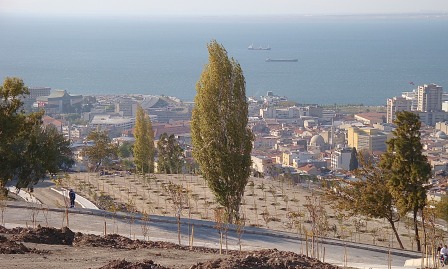
As in all big conurbations it helps to find a lofty viewpoint from which to survey the terrain. In İzmir two possibilities immediately spring to mind. The first is Kadifekale (Velvet Castle), the hilltop fortress dating back to Byzantine times that forms a backdrop to Basmane and Konak. The remains of the fort itself are not especially exciting, but the views over the Gulf of İzmir are spectacular. The hillside has been cleared to improve the landscaping, uncovering the old Roman theatre in the process.
Alternatively, you can head south from Konak in search of the Asansör (lift) at Karataş, a rather unexpected brick tower set amid pretty cobbled streets that was paid for by the Jewish banker, Nesim Levi Bayraklıoğlu, in 1907 to help the wealthy access their hillside mansions without breaking into a sweat. One glimpse of the view from the cafe at the top is likely to have you wedded to your chair over more drinks than you’d probably planned for.
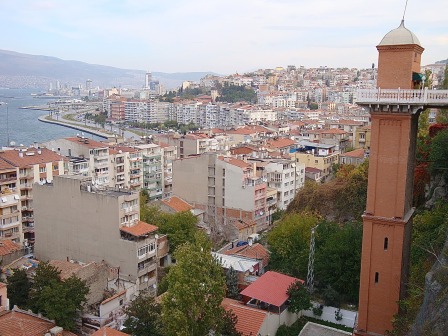
As the sun sets, everyone heads straight for the waterfront. Hard though it is to credit it now, there were once plans to build a concrete motorway right along the waterfront. Fortunately, the late mayor Ahmet Piriştina (1952-2004) scrapped them in favour of the promenade that now runs almost all the way from Konak Pier in the south to Alsancak in the north.
This is where the locals come to soak up the sea air. It goes without saying that a series of inviting cafes and restaurants are lined up all along the promenade so diners can watch the sun dipping into the sea as they tuck into tasty fish suppers.
Most of the waterfront restaurants are on the pricy side. If you cut inland to Alsancak, however, you will find narrow cobbled streets lined with old Ottoman Greek houses, many of them converted into small cafes and restaurants alternating with bars that keep the music pumping into the early hours.
Eating
For an atmospheric lunch in the bazaar grab a table at Hisarönü in front of the Hisar Cami. Prices are marked up a little to reflect the tourist trade.
İzmir specialities to look out for include innocuous patlican böreği (aubergine-filled pastry) and söğüşü, a sandwich made from cold meat parts most of us try to forget exist – brain, cheeks and tongue.
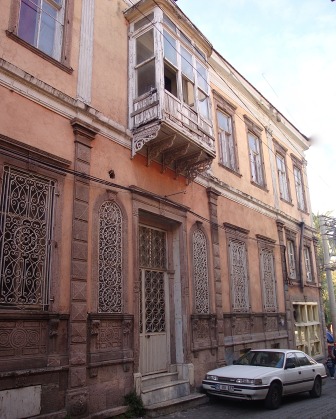 Many late 19th-century/early 20th-century houses in Basmane now house very basic hotelsSleeping
Many late 19th-century/early 20th-century houses in Basmane now house very basic hotelsSleeping
One of İzmir’s biggest problems is a shortage of decent, reasonably priced accommodation. So far no one has converted any of Alsancak’s old houses into a boutique hotel which leaves visitors struggling with the mainly grungy but cheap offerings around Basmane or the cleaner but overpriced business-class hotels around Cumhuriyet Meydanı.
What is a budget traveler to do? One option is to stay in nearby Selçuk or Kuşadası and come into town for the day. Inevitably, though, the cheaper bed comes at the price of missing out on İzmir’s flourishing nightlife.
Otel Kilim. Tel: 0232-484 5340
İzmir Palas Oteli. Tel: 0232-465 0030
Otel Karaca. Tel: 0232-489 1940
Konak Saray Hotel. Tel: 0232-483 7755
Hilton İzmir. Tel: 0232-497 6060
Areas of İzmir
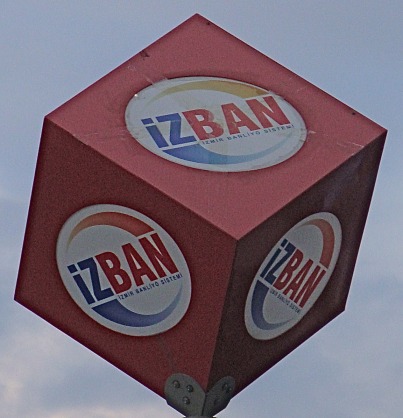 Transport info
Transport info
You can fly from İstanbul, Ankara or Kayseri to İzmir’s Adnan Menderes Airport (ADB) which is connected to the town centre by train.
Buses from İstanbul take eight hours to reach İzmir.
There are trains to İzmir from Denizli and Selçuk, and buses from most major cities. Most buses arrive and leave from the huge main Otogar on the outskirts of town but this is slated to be moved to Bornova soon.
Buses to Çeşme and other places on the Karaburun Peninsula leave from the small western Üçkuyular bus terminal – the nearest Metro stop is Fahrettin Altay.
İzmir suffers from the usual big-city transport problems but the linking of the İzban railway with the Metro has made it much easier to get around. For the time being neither runs to the main bus terminal but this is a situation that should change in the near future. (http://www.izban.com.tr/).
Note that Cumaovası is actually the station for the small town of Menderes.
Day trip destinations
Read about the İzmir aqueducts: http://www.turkeyfromtheinside.com/blogbloggingaboutturkey/entry/28-the-izmir-aqueducts.html
Read more: Chain-Store Satisfaction
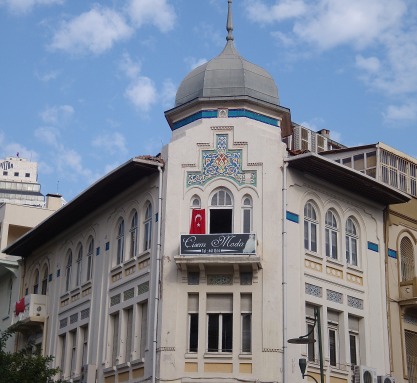 İzmir has many fine examples of the First National style of architecture
İzmir has many fine examples of the First National style of architecture


